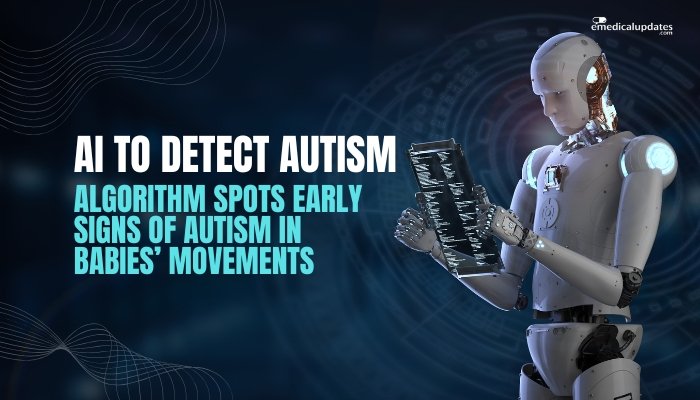Introduction
Autism is typically diagnosed around toddlerhood, although subtle signs may arise in infancy. Early identification can be critical for timely interventions, often improving language, social, and cognitive skills. Now, researchers have developed an AI-based algorithm that analyzes infant movements—like limb coordination or posture—to spot potential markers of autism spectrum disorder (ASD).
By flagging subtle irregularities or delays early on, clinicians and parents might initiate targeted therapies even before typical evaluations begin. Below, we explore how the AI works, its preliminary results, and what it could mean for autism screening and interventions.
The Importance of Early Autism Detection
Current Diagnosis Gaps
- Later Diagnoses: Often, children are diagnosed around 2–4 years old, missing key early windows when the brain is highly plastic.
- Subjective Observation: Evaluations rely on parental recall and clinical behavior checklists. Subtle signs might be overlooked or downplayed.
Potential Benefits of Early Screening
Earlier detection can facilitate:
- Early Intervention: Speech, occupational, or behavioral therapies can start sooner, boosting developmental progress.
- Lower Stress for Families: Clarity and structured support reduce uncertainty, enabling more informed caregiving strategies.
AI-Focused on Infant Movements
Analyzing Micro-Movements
The algorithm typically processes videos of babies’ spontaneous movements (arms, legs, head control). Using computer vision and deep learning techniques, it identifies:
- Movement Patterns: Frequency, fluidity, asymmetry of limb motions.
- Postural Stability: How the infant’s trunk or neck maintains control over time.
- Motor Milestone Tracking: Rolling over, sitting unassisted, etc.
Why Movement?
Neuromotor differences often appear in children who later develop autism, even if subtle. Infants with certain atypical movement patterns may reflect underlying differences in brain development or sensory-motor integration.
Early Study Outcomes
Data Collection
Researchers gather video footage of infants—some at high risk for ASD (e.g., with an older autistic sibling), others in a general population sample. The AI system then combs through hours of footage:
- Automated Feature Extraction: Software quantifies angles, velocities, or smoothness of gestures.
- Comparison to Normative Models: Differences from typical infant motor patterns can predict higher risk for autism.
Prediction Accuracy
Preliminary results show the algorithm:
- Identified Elevated Risk for ASD with moderate to high accuracy—some studies report specificity and sensitivity upwards of 80% or more.
- Earlier Than Traditional Tools: Potentially signaled concerns at 6–12 months, well before the standard 18- or 24-month screening typically used in pediatric visits.
How This AI Could Transform Screening
- Remote and Low-Cost: Parents could record short home videos, upload them for analysis, bridging geographical or resource constraints.
- Objective Assessment: Reduces subjectivity inherent in parent or clinician observational methods.
- Personalized Pathways: If flagged, families might begin therapy or further evaluation, leading to more tailored support plans.
Limitations and Challenges
Validation and False Positives
Larger, diverse datasets are needed to ensure consistency across different ethnic groups, birth contexts, or co-occurring conditions. Overdiagnosis or false alarms might cause parental anxiety and strain healthcare resources.
Ethical and Data Privacy Concerns
Video data of infants require careful handling and robust privacy protections. Ensuring secure storage and compliance with regulations is paramount.
Integration into Clinical Pathways
While promising, AI-based movement screening won’t replace thorough developmental assessments. Pediatricians and specialists must figure out how to incorporate such tools responsibly into routine practice.
Future Directions
Refining Algorithms
Additional input data—such as audio or parent questionnaires—might increase accuracy. Machine learning models could evolve to interpret facial expressions or social cues along with movement patterns.
Global Adoption
If widely validated, an app-based approach might spread to low- and middle-income countries, helping communities with limited access to developmental specialists. This could democratize early autism screening and reduce diagnostic disparities.
Collaborations in Research
Child development experts, ethicists, software engineers, and healthcare professionals are joining forces. The synergy fosters more reliable, context-aware tools bridging technology and pediatric care.
Frequently Asked Questions
- Does the AI tool diagnose autism outright?
- No. It identifies potential risk indicators. A formal diagnosis still requires clinical evaluation by specialists.
- At what age can the tool start analyzing movements?
- Typically from a few months old—some algorithms start around 2–6 months, though specifics vary by study.
- Does it replace well-baby visits and screenings?
- Not at all. It supplements them, offering a new objective measure but not negating the need for pediatric or specialized assessments.
- What about children with known motor impairments or other special health conditions?
- Additional validation is needed for complex cases. Some coexisting conditions might skew movement patterns.
- When might this technology be publicly available?
- It’s in pilot or early-stage adoption in some research settings. Commercial or mainstream healthcare adoption may be a few years off, pending further validation and regulation.
Conclusion
The idea of using AI to detect autism early by analyzing infant movements underscores the potential of technology to revolutionize child development screening. This approach can spot subtle motor anomalies that might predict later ASD diagnosis, granting families an opportunity for earlier, more impactful interventions. Yet as with any novel method, scaling it for clinical use requires broader trials, robust ethical frameworks, and collaboration across disciplines. If successful, such AI could become a powerful ally in bridging the typical multi-year gap between initial parental concerns and official autism diagnoses, ultimately improving outcomes for countless children.



